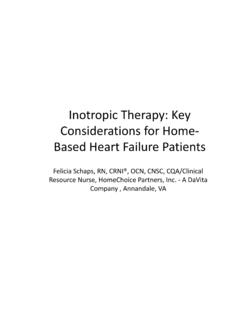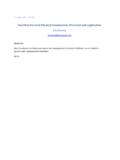Transcription of Key Strategies for Developing a Competency …
1 Key Strategies for Developing a Competency assessment ProgramMargherita C. Labson RN, MSHSA, CPHQE xecutive Director Home Care ProgramThe Joint CommissionOakbrook Terrace, IL Tony Powers, , Medical AlternativesMemphis, TNCE Credit in Four Easy Steps!1. Scan your badge as you enter each session. 2. Carry your Evaluation Packet to every session so you can add session evaluation forms to Track your hours on the Statement of Session Attendance Form as you go. 4. At your last session, total the hours and sign both pages of your Statement of Session Attendance Form. Keep the PINK copy for your records. Put the YELLOWand WHITE copies in your CE Envelope. Make sure an Evaluation Form is in your CE Envelope for each session you attended. Miss one? Extras are in a file near Registration.
2 Fill out the information on the outside of the CE Packet envelope, seal it, and drop it in the box near Registration. Applying for Pharmacy CPE?If you have not yet registered for an NABP e-Profile ID, please visit to do so beforesubmitting your packet. You must enter your NABP e-Profile ID in order to receive CE credit this year!3/26/20132 Speaker DisclosuresThe speakers have no conflicts of interest to disclose and no off label or investigational use of drugs or products will be made during the AssessmentObjectivesAt the conclusion of the session the participant will be able to:1. Define Competency and its relationship to individual and organizational performance2. Describe the role of leadership in creating a culture that supports staff competenceCompetency AssessmentObjectivesAt the conclusion of the session the participant will be able to:3.
3 Describe the skills needed by staff assigned to evaluate competency4. Review examples of Competency assessment tools for home infusion staff members including pharmacy, nursing, distribution, reimbursement, and marketing staffCompetency AssessmentCompetency is the individual s actual performance in a particular situation. Competency is concerned with how well an individual demonstrates their knowledge, skills, abilities, attitudes and behaviorsin accordance with expectations. Competency AssessmentKnowledgeinvolves understanding facts and procedures. Pre service education In service training On the job experience Feedback from supervisors and peers Continuing educationCompetency AssessmentSkillis the capacity to perform specific actions: a person s skill is a function of both knowledge and the particular Strategies used to apply knowledge.
4 Actions Gained through hands on training Measured by level (Ex: Novice, Competent, Proficient, Expert) Competency AssessmentAbilitiesrefers to the power or capacity to do something or act physically, mentally, legally, morally, etc. Abilities are gained or developed over time and, as a result, are more stable than knowledge and skills. Competency AssessmentTraitsrefers to distinguishing characteristics or qualities, especially of a personal nature. Self control Self confidence Many traits are slow to change or even IncludesCompetencyKnowledgeSkillsAbiliti esTr aitsAttitudes BehaviorsCompetency assessment Core generic process or skill that crosses all departments and job categories. High Risk a process or skill that if not correctly performed affects the organization s quality, service or cost Low volume a process or skill that is not done frequently enough to be observed by a peer or leader and therefore demonstrated performance is not known.
5 Problem prone a process or skill that by virtue of the number of steps or difficulty is inclined to mistakes. Critical processes vital to the organizations successCompetency assessment Therapies Provided Comprehensive of all components (Medications, VAD, Supplies, Equipment) Patient Populations Served Functionally linkedto outcome indicatorsExploring the Role of Leadership PPACA Paradigm shift in Health Care Delivery Moving from patients to populations Rethinking Models of Care Partnering through Affiliation Pitfalls to AvoidPotential Risk Points: Overestimating Capabilities Balancing Interests and Engaging Stakeholders Recognizing InterdependenceDemand for ^ Reliability Organizations that can manage serious hazards extremely well. Preoccupation with failure Reluctance to simplify interpretation Sensitivity to operations Commitment to resilience Deference to expertiseUnderstanding Leadership s Role in CultureArtifacts & PracticesNorms and Behavior PatternsValues-BeliefsAssumptionsWhat is Leadership s Role?
6 Accountability Commitment that safety is a priority Visibility Engagement Regular training Effective Communication StandardizationRoutinely Ask Can I recognize the small signals of a failure and make sense of them? Do I appreciate the differentiation in this situation? Am I aware of the situation that is unfolding? Who knows how to do what?Supervision & Evaluation to watch an activity being carried out by somebody and ensurethat it is performed correctly to consider or examine something in order to judgeits value and/or Requisite Skills of the Evaluator Focused, real time awareness Unbiased, objective approach Nonintrusive observation Competent motivational interview skills Thoughtfully organized Sequentially oriented Constructive demeanorMotivational Interviewing Strategies and Techniques Asking Permission Eliciting/Evoking Change Talk Exploring Importance and Confidence Reflective Listening Normalizing Decisional Balancing AffirmationsObserving Operations Maintaining nonintrusive presence Timing questions and comments appropriately Seeking clarification and validation Key points to remember.
7 Stay present in the moment Keep your opinions in check Reflect on what you see and hear Make your notes discreetlyEngaging Staff Explaining the objective Securing permission Getting buy in Essentials to include: Staff s current determination of individual s status The focus of the most recent activity with individual The purpose of today s visit Opportunities and challenges staff has identifiedKnowing where to Consider the objective Select the appropriate data rich context Self identify potential to insert bias Determine the appropriate methodology Clarify and verify, remediate in real time Document, follow through, celebrate Competency IncludesCompetencyKnowledgeSkillsAbiliti esTr aitsAttitudes BehaviorsCompetency assessment Written or Computer Based Examination Performance Records (Review of medical records) Physical Models (Anatomical Models)
8 Job Simulation Job SampleCompetency assessment MethodsKnowledgeSkills / AbilitiesWritten / Computer Based ExaminationRecord ReviewPhysical ModelsJob SimulationJob SampleExample Competency Plan for Home Infusion PersonnelBaseline and Annual All Employees Core Competencies (Net-Learning Computer Based Learning System) Blood borne Pathogens Infection Control Influenza Chain of Command Risk Management Confidentiality of Information Including Red Flags Disruptive Behavior Security Fall Prevention Example Competency Plan for Home Infusion PersonnelBaseline and Annual All Employees Core Competencies (Net-Learning Computer Based Learning System) Patient Rights Population Served: Age Appropriate Care Older AdultsAdultsAdolescentsNewborns to School Age Professional Responsibility Standards of Conduct Example Competency Plan for Home Infusion PersonnelBaseline and Annual All Employees Core Competencies (Net-Learning Computer Based Learning System) Understanding the HIPAA Privacy and Security Rules Cultural Sensitivity Fraud Waste and Abuse Emergency Management Handling Hazardous Materials Fire Safety Abuse and NeglectCompetency assessment ResourcesExample Competency Plan for Home Infusion PersonnelBaseline Pharmacist Competency AssessmentNHIA Infusion Therapy Module Program (All 7 Modules)Module 1: Introduction to Home Infusion PracticeModule 2: Overview of Home Infusion ReimbursementModule 3.
9 Overview of Infusion Devices, Vascular Access Devices, and Ancillary SuppliesModule 4: Nutrition Therapies: Parenteral Nutrition, Enteral Nutrition, and HydrationExample Competency Plan for Home Infusion PersonnelBaseline Pharmacist Competency AssessmentNHIA Infusion Therapy Module Program (All 7 Modules)Module 5: Introduction to Home Infusion Therapies: Anti-Infectives, Chemotherapy,Pain Management, and Miscellaneous TherapiesModule 6: Compounded Sterile Preparations in Home InfusionModule 7: Overview of Financial and Operational Issues in Home Infusion Therapy Example Competency Plan for Home Infusion PersonnelBaseline Pharmacist Competency assessment ASHP Compounding Sterile Preparations (Video / Workbook) (Used if no previous experience) Aseptic Process Validation (USP 797)USP 797 Appendix(s) (All specifically 3-5) Corporate Policy and Procedures Infusion Device (Pump) Skills Demonstration Example Competency Plan for Home Infusion PersonnelBaseline Pharmacy Technician Competency assessment NHIA Infusion Therapy Module ProgramModule 1: Introduction to Home Infusion PracticeModule 2: Overview of Home Infusion ReimbursementModule 3: Overview of Infusion Devices, Vascular Access Devices, and Ancillary SuppliesModule 6.
10 Compounded Sterile Preparations in Home Infusion Example Competency Plan for Home Infusion PersonnelBaseline Pharmacy Technician Competency assessment ASHP Compounding Sterile Preparations (Video / Workbook) (Used if no previous experience) USP 797 Appendix(s) (All specifically 3-5) Corporate Policy and Procedures Infusion Device (Pump) Cleaning / Testing Example Competency Plan for Home Infusion PersonnelSemi-Annual / Annual (Based on USP Risk Level and Organization Preference) Pharmacists & Pharmacy Technicians Aseptic Process Validation (USP 797)Multiple TransfersNon-Sterile to Sterile (Including Filter Bubble Test) New / Updated Policy and Procedures New Therapies (Medications) and/or Patient Populations New / Updated Pumps (Cleaning / Testing) New / Update VAD s (Supply Requirement)Example Competency Plan for Home Infusion PersonnelBaseline Driver Competency assessment Corporate Policy and Procedures NHIA Infusion Therapy Module Program Module 1: Introduction to Home Infusion PracticeModule 2: Overview of Home Infusion ReimbursementModule 3: Overview of Infusion Devices, Vascular Access Devices, and Ancillary Supplies Corporate Policy and Procedures Example Competency Plan for Home Infusion PersonnelAnnual Driver Competency assessment Corporate Policy and Procedures New Therapies (Medications) and/or Patient Populations New Infusion Devices Example Competency Plan for Home Infusion PersonnelBaseline Reimbursement Competency AssessmentNHIA Infusion Therapy Module Program Module 1.










